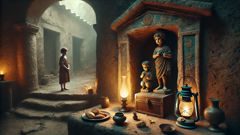Introduction
Beneath the patina of bronze and marble, beneath the triumphant names and lists of magistrates, the founding of Rome begins with a quieter, more dangerous history. Along the braided banks of the Tiber, where reeds whispered and foxes padded through clay, the story of twin boys emerges not simply as a tale of destiny but as a knot of oaths, exile, and divine politics. The familiar outline — a Vestal violated, a godly father, a she-wolf's compassion, a hill split by fate — is only the surface. Hidden beneath are rival genealogies that claim descent from Aeneas and from the older kings of Alba, delicate cultic details about the Vestal Rhea Silvia, and prophecies recorded in scraps and ritual songs that later Roman priests took pains to preserve. The stakes were not merely the founding of a city; they were the right to a name, the claim to a people, and the favor of gods who measured their alliances in omens and blood. In the hush of river fog and the smoke of hearths long gone cold, the twins grew into figures both beloved and contested — proof that every origin myth is as much about what people fear losing as what they hope to gain. This account seeks those shadowed corners: the conversations in midnight courtyards, the dressed stones of neglected altars, and the small, human cruelties that ritual and rumor bend to make eternal. It follows the divine parentage and the less-remembered rival claims, the silent bargains struck with augurs and queens, and the catastrophic decision that divided brothers and birthed a city. Told with attention to the cultural and religious textures of the age, this deeper lore aims to restore the voices that the triumphal arches later forgot.
Divine Parentage and Hidden Lineage
To speak of Romulus and Remus begins inevitably with a claim to the heavens. The accepted version offers Rhea Silvia, a Vestal whose chastity was sacred to the goddess Vesta, and Mars, the war god, as parents. That claim served a purpose: it placed the founders of Rome beneath a divine patron and justified, in religious terms, the martial temperament of the city that would rise. Yet ancient households and rival cities kept other stories, and those variants reveal more about early Roman identity than the tidy genealogy rehearsed by Renaissance scholars.

One persistent strand ties the twins to Aeneas, the Trojan hero whose passage to Italy reshaped the peninsula's political imagination. For some families of the Latin plain, boasting descent from Aeneas was a way to stake a moral claim to land and precedence. In those tellings, Romulus and Remus are not simply sprung from a god but are heirs to a complicated lineage where human exile, divine favor, and political marriage converge. Aeneas's line, marked by the piety and wanderings that Homeric echoes ascribe to him, confers a sense of earlier, more cosmopolitan ancestry. Linking the twins to Aeneas smoothed disputes with other Italic communities, creating a shared origin story that could be summoned during oaths and treaties.
Rhea Silvia herself is a figure of paradox. As a Vestal she embodied continuity — Vesta's eternal flame, household sanctity, public law. As a mother she became the locus of scandal and reverence. Some accounts emphasize coercion, others a clandestine union with Mars, suggesting either divine seduction or human manipulation. The political context matters: vestal virgins were sometimes removed from their positions to resolve succession crises or to silence claims. In one obscure tradition, a faction at Alba Longa sought to invalidate the reigning line by revealing that the queen had broken ritual law, thereby legitimizing rivals who alleged more reliable descent. Thus the myth's focus on divine parentage can be read as a narrative device that both sanctifies and obscures human schemes.
Priestly families preserved liturgies that hint at a more complex celestial involvement. Augural tablets and fragmentary ritual lists mention a nocturnal vision and scratched omens — a star, a she-wolf seen in a dream, a sign of iron on a river's breast — that augurs later interpreted to mean that two boys would found a community under a new law. These details suggest ritual calibration: if the city's founders could be read into the heavens, their authority extended beyond force to a cosmic sanction. The political consequence was significant. When Rome's earliest patrician houses sought recognition, they did not rely solely on the sword. They invoked priestly memory, quoting obscure auguries to assert that their privileges were part of an original arrangement between men and gods.
And yet the divine claim did not erase human grief. The mortal dimensions of the twins' family — their throwaway abandonment, the patronage of shepherds, the protection by a she-wolf — point to precarious human networks. Shepherds and woodcutters, those lowest of pastoral castes, become the stewards of Rome's origin. Their names and rituals, rarely recorded in grand annals, persist in colonial songs and in neighborhood cults that later Romans would treat as quaint survivals. These local cults were more than nostalgia; they were political memory. When a family recited how their ancestor tended Romulus and Remus, they were claiming intimacy with the city's inception, a kind of sacramental proof of belonging.
There is also a darker thread, one that modern readers find all too human. Rival claims to the throne of Alba Longa, calculated murders, and forced exile converge to create the conditions that make the twins' abandonment plausible. The grand arch of divine intervention is, in many versions, a cover over palace intrigue. A daughter forced into the temple to remove her bloodline from succession; a jealous king conspiring to end the line; a queen's secret lover revealed to be a god — each of these details speaks of power secured by breaking bonds. The myth, then, doubles as a cautionary tale about the fragility of legitimate rule and the way that sanctity can be weaponized to erase rivals.
What remains striking is how later Roman institutions absorbed these stories and transformed them into civic practice. Vestal rites, the cult of Mars, augural procedures — all became ways to ritualize victory and to make ancient violence respectable. The statues, the calendar festivals, the ritual songs preserved not only memory but a blueprint for legitimizing new elites. When a family claimed to be descended from the twin founders, it wasn’t simply a boast of ancestry; it was an assertion that the gods themselves had sanctioned their dominance. In that sense, the divine parentage is less a testament of miracle than a device of social order. It knitted together religious belief, legal authority, and the raw human ambition that propelled Rome from a cluster of huts into an empire.
The Twins' Childhood, Rivalry, and the Hill of Fate
Childhood in early Latium could be spare and cunning. For Romulus and Remus, survival depended on improvisation. The pastoral household that raised them taught toughness: how to read weather from cloud, how to find a spring by the taste of grasses, how to hide tracks from men who might claim reward for outsiders. Shepherds were the unsung tutors of the earliest Roman virtues — endurance, quick thinking, and a rough equality born of shared hardship. In the shadow of Alba Longa, these lessons hardened into a habit of mind that later myths translated into the boys' leadership.

Yet those formative years contained seeds of division. The stories insist the twins were inseparable, but intimacy often smoldered with latent rivalry. Differences crept in: Romulus, stern and strategic; Remus, impulsive and mocking. Their temperaments originated in necessity. Romulus learned to measure advantage, to build enclosures and read stellar patterns for direction. Remus, more given to jest, learned to challenge custom — a dangerous trait when law was still being invented. Their conflict did not erupt suddenly; it gathered like stormlight, visible to those who watched for omens: a quarrel at the communal fire, a dispute over the chief flocks, a mockery that turned into a grudge. When the brothers joined gangs of freedmen and shepherd lads, those informal circles became the nascent body politic — factions that would soon crystallize into the parties of a new city.
The choice of city site reveals the struggle between planned order and ecstatic claim. Romulus favoured the Palatine, with its defensible crest and clear water sources; Remus preferred the Aventine, open and generous but less easy to fortify. Their dispute over where to establish the city thus had pragmatic roots — a choice between fortification and abundance — but it also reflected their competing visions. Romulus sought ordered institutions, walls and gates, a structure that would reward discipline and ritual obedience. Remus imagined a looser community where hospitality and ease shaped law. Their visions were political platforms as much as personal preferences.
When augury was called to adjudicate, it should have offered neutral arbitration. Instead, augural practice — with its careful rules about birds, directions, and timing — became another arena of competition. Augurs were not simply seers but powerbrokers. In the contested foundation story, each side produced omens in a manner that underscored affiliations: Romulus's watchers claimed a flock of auspicious birds over the Palatine, while Remus's countersigns involved mischievous crows and a sudden gust that toppled a brazier. The public's interpretation of these signs hinged on the credibility of the observers and their patrons. In a society where memory was oral and priestly families jealously guarded ritual expertise, the result was ambiguity. The twins’ argument thus moved from brotherly sparring into institutional struggle.
The famous rupture — Remus leaping the nascent walls and Romulus slaying him — compresses a series of smaller betrayals and strategic calculations. In some tellings, Remus’s mock leap is a youthful dare that goes tragically wrong; in others, it is an assertive act of political theatre meant to shame the builder into generosity. The leap becomes a test: a claim that walls cannot hold a true city which does not permit the free movement of its sons. Romulus’s response — whether a blow in anger or a formal execution — codified the preference for boundary and law over ostentatious liberty. The act transformed personal loss into civic foundation. The blood spilled in a moment of fraternal fury sanctified the wall: the city would be built upon the recognition that order may demand sacrifice.
There are suggestive alternative accounts in late and local traditions that complicate the simple tale of fratricide. Some describe a judicial council convened after the breach in which elders, pressured by nobles who favored a strong, walled polity, pronounced sentence. Others preserve an image of Remus dying not by Romulus's hand but in skirmishes with rival shepherd bands who opposed his challenge. These iterations hint at a political sanitization: the murder of a brother becomes a legal precedent for punishing transgression, a rule that crafted citizenship through exclusion as much as inclusion. The ritual that later Romans marked with stone and sacrifice thus concealed a legal revolution — a shift from kin-based claims to a civic identity enforced by walls and magistrates.
Beyond politics and law, the twin's tragedy carried a spiritual cost. Remus's death haunted early rites; at times his memory was honored in quiet neighborhood commemorations, small sacrifices left by those who remembered him as a wronged son. Romulus's later cult, by contrast, was public and triumphant. He became a hero whose apotheosis was shaped to erase the more ambiguous parts of his rise. The funerary practices and local songs that mourned Remus were kept alive by rural cults, furtive and persistent. They remind us that official mythmaking never wholly effaces private grief.
The contested nature of the foundation explains why Rome's origin story remained a working myth for generations. It was reshaped to suit new rulers, to justify land grabs, and to reconcile former enemies. As Rome grew, the tale of two brothers became a prism through which Romans read questions of legitimacy. Did power derive from ancestral favor or from the city's laws? Were the gods the final arbiters, or could mortals, by force and cunning, decide destiny? The answer Rome gave was pragmatic: both. The divine parentage provided sacred cover; the prosecution and funeral rites of Remus gave law and ceremony the necessary gravity. In the end, a city rose that could claim heavenly ancestry while practicing earthly ruthlessness. The legacy of that paradox would shape not just Rome's origin story but the way its people understood victory and loss for centuries to come.
Conclusion
The deeper lore of Romulus and Remus shows that Rome’s beginning was a palimpsest of devotion and violence, ritual and rivalry. The divine parentage that sanctified the city's founders is inseparable from the human maneuvers that produced them — courts that silenced rivals, priestly claims that sanctified power, and small communities whose memories kept the lost brother alive. In these shadows we find a lesson about origins: foundation myths are not simple proclamations of destiny but instruments used to shape future authority. They compress grief into monument, erase inconvenient truths with ceremony, and teach new generations how to interpret signs. Remembering Remus's quieter commemorations, the obscure auguries, and the contested lineage tied to Aeneas gives the foundation myth its necessary complexity. It also restores the voices of those who were left outside the triumphal narrative — the shepherds, the rural cults, the women and priests whose whispered rituals shaped the city's legitimacy. In tracing these lesser-known threads, we encounter a Rome that was forged as much by sorrow as by glory, a city whose walls enshrined both a claim to heaven and the cost of human division. That duality — sacred favor entwined with fraternal loss — endures in the city’s memory, reminding us that every founding song must reckon with the price it demands.













